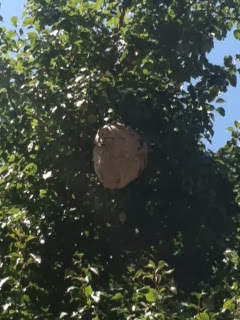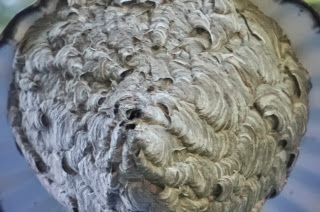Bald Faced Hornet Nest Removal Acton, MA
Acton, MA - Check out these pictures of a bald faced hornet nest removal. It featured over 10,000 hornets:
Bald Faced Hornet Nest Removal Boxborough, MA
Boxborough, MA - The pictures below are of a recent bald faced hornet nest we removed:
Pest of the Month - Bumble Bee
| |
|
Pest of the Month - Cicada Killer
- Large solitary wasps measuring 1 -9/16 inches in length.
- Gets their name from its use of Cicada’s as food for their young.
- Many may fly together over a particular area/burrow but they do not nest together. Each female digs her own burrows up to 10 inches deep and extend 6 inches horizontally.
- Burrows have dirt piles up at their entrances.
- The Cicada killer locates a cicada, paralyzes it and brings it back to the burrow. It is placed in the burrow with one deposited egg.
- The wasp larvae feed on the paralyzed but still living Cicada.
- Full grown larvae hibernate in burrows, pupate in spring and emerge the following summer as adults.
- Can cause extensive lawn damage. However reduces Cicada population.
- Can be frightening to home owners because of their large size and massive population.
- They do sting, but only when provoked.

Did You Know Paper Wasps Can Recognize Faces?
Recent research has discovered paper wasps have face recognition abilities comparable to humans. One recent study conducted at the University of Michigan in Ann Arbor showed paper wasps have the same facial recognition abilities common to humans or chimps.
"Faces are extremely important to species such as humans", said the study coauthor Michael Sheehan, a Ph.D. candidate at the university. "Studies show that when you look at a face, your brain treats it in a totally different way than it does other images," he said. "It's just the way the brain processes the image of a face, and it turns out that these paper wasps do the same thing."
The study consisted of a series of tests on the Polistes fuscatus species of paper wasp. This particular species is unique in that it has extremely variable facial patterns from member to member. Sheehan and evolutionary biologist Elizabeth Tibbetts placed individual wasps into a T-shaped maze, with one image shown at each end of the top T arm. Images varied from caterpillars, simple geometric patterns, and computer-altered wasp faces to pictures of a genuine paper wasp faces. These images were interchanged randomly during testing.
According to Sheehan, whenever the wasp in the maze chose the side of the T arm with the correct picture, it would get a reward, in this case a safety zone. Though images were always changed, "one particular image was always associated with the safety zone," Sheehan explained. Once the wasps associated the right image with the safety zone, they were able to choose the correct image and thus get to the safety zone essentially every time after. This suggests that the paper wasps' brains are tuned to recognize faces of their own species -- as with humans.
"Wasps and humans have independently evolved similar and very specialized face-learning mechanisms, despite the fact that everything about the way we see and the way our brains are structured is different," Sheehan said. "That's surprising and sort of bizarre." The unique, distinct faces of paper wasps, as well as the wasps' ability to recognize and remember each other's faces, are likely tied to the insects' multicolony social structure, Sheehan added. "They have multiple queens and they all want to reproduce—they all want to be the most dominant. So being able to recognize each other helps them understand who's already beaten who, who has higher ranking in the hierarchy, and this helps to keep the peace."









